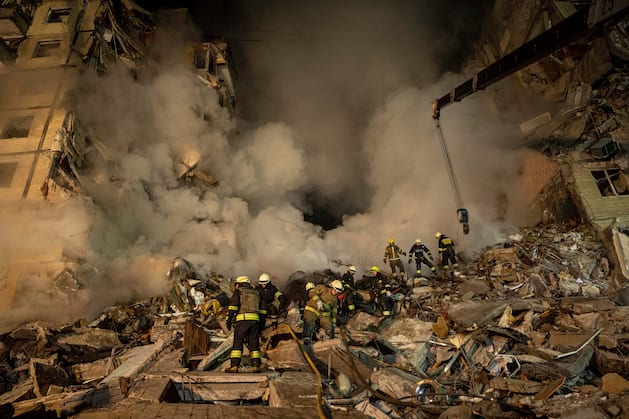Despite Western sanctions against Russian arms companies, rockets whose electronics were manufactured in Germany, the EU and North America continue to hit Ukraine. Turkey obviously deserves some of this.
Western states’ technology sanctions were intended to slow down Russia’s production of modern cruise missiles, tanks and other weapons. According to logic, Putin needs semiconductors from Europe and the USA for the electronics of his war machine. However, Ukrainian soldiers are finding more Western components in recently produced Russian weapons. What’s behind it?
“Without Western technology,” says James Byrne of the Royal United Services Institute for Defense and Security Studies (Rusi), “the Russian army could not wage the war against Ukraine as it has been doing for months.”
A closer look reveals significant holes in the western sanctions. According to Reuters, at least $777 million worth of western electronics found their way into Russian military equipment in the first seven months of the war. They come from US corporations such as Intel, AMD and Texas Instruments, but also from Infineon from Neubiberg near Munich.
According to research by the editorial network Germany (RND), Russia obtains western technology for the weapons with which it shells Ukraine in five ways:
The Russian arms industry, which has been subject to Western sanctions since the annexation of Crimea in 2014, had apparently prepared for tightened restrictions after the Ukraine attack. In the period leading up to the February 24 invasion, she imported large quantities of electronics, the RND reports. She used these supplies to manufacture weapons despite sanctions.
However, supplies are running low, observers say. The Russian armaments have already significantly reduced their production or switched to older weapons. However, thanks to electronics smuggled into the country, they continue to manufacture some new types of rockets.
Mainly because of these smuggling operations, Western electronics continue to be part of Russian weapons. The example of Infineon shows how difficult it is to prevent them.
The company instructed all distribution partners immediately after the Russian attack on Ukraine to “prevent deliveries of Infineon products or services that violate the sanctions,” the company told the RND. However, it cannot completely prevent this: At some point, the track is lost through resale of computer chips and other components. Then they can end up anywhere, including in Russian missiles.
The most important trading point for smuggled electronics is apparently in Turkey. Even before the war began, Russian entrepreneurs founded their own companies there that supply important technology to their home country’s defense industry, Rusi expert Byrne told RND.
Because the EU and US economic sanctions do not apply to Turkey, Byrne said ships, planes, cars and trains would continue to bring them from there to Russia “without any problems”. The stopover trade undermines the sanctions.
Several German companies are also said to have used Turkey as a transhipment point for prohibited deliveries to Russia, reports the RND. It doesn’t mention names.
Experts who evaluated Western electronic components found in Russian weapons revealed a second loophole in the sanctions: Many components come from household appliances.
The West continues to have products such as mobile phones and laptops delivered to Russia in order to keep the people there able to access information away from the state media. Blogs, news services like Telegram and Western media are supposed to expose Putin’s propaganda. Weapons manufacturers use this loophole, slaughtering cell phones and laptops and building their chips, hard drives and other electronics into weapons.
No missiles currently deployed in Ukraine are the same, András Rácz, an expert on Russian defense policy at the German Council on Foreign Relations (DGAP) told RND. The armaments industry manually manufactures different components in each missile. This slows down production, but lets it continue in small numbers.
Experts say Russia’s dependence on China and India is growing. Air-cargo traffic between China and Russia has increased so much since the beginning of the war that Chinese airlines such as Air China and China Eastern Airlines have already converted passenger planes into freighters, RND reports, citing industry sources. Apparently, the transported goods also include semiconductors for weapons. Important components of Russian drones are said to come from Hong Kong.
The USA is already sanctioning the Chinese group Sinno Electronics for dealings with Russian armaments companies. According to RND, however, experts expect sanctioned owners to set up new companies that continue interrupted businesses.
However, according to Rusi expert Byrne, Asian technology cannot completely replace Western imports for Russia. DGAP expert Rácz believes the Russian army is bleeding dry. “Because of the high losses of military material, Russia will have to reduce the intensity of its fighting by autumn at the latest.”
In order to slow down this process, Russia apparently uses smugglers in the West. In October 2022, Yuri Orekhov was arrested in Germany. According to US Attorneys who requested access, he is part of a network of Russian and Venezuelan smugglers selling sanctioned Western technology to Russian companies.
Russian nationals residing in the West are said to be buying electronics from front companies and smuggling them to Russia with forged documents via China, South Korea and Hong Kong.
Despite all efforts, according to Rácz, time is ticking against Russia. The armaments industry is working at full speed, but in view of the largely missing electronics, it is mainly producing outdated weapons. In addition, the military is losing more machines in Ukraine than Russia is reproducing.
So the Western sanctions may be full of holes. Apparently they still achieve their goal.















